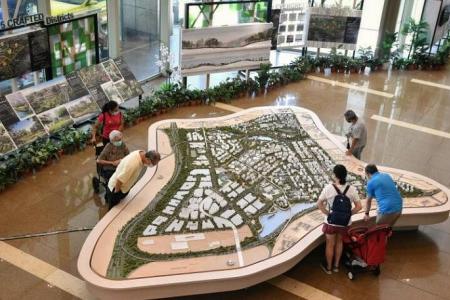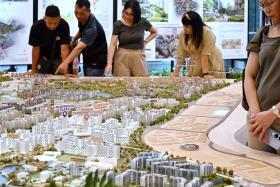HDB details how it prices BTO flats and the developments costs
Build-to-Order (BTO) flats are priced such that they remain affordable for buyers – an approach that is “fundamentally different” from private developers, who price their residential units for profit, said the Housing Board on Wednesday.
In a statement, HDB added that as BTO flats are highly subsidised, their selling prices cannot fully cover development costs, which include construction and land costs.
In the 2021-2022 financial year, the total development costs for the 13,506 new flats HDB handed over to buyers came up to $5.346 billion.
Giving a breakdown of the development costs, HDB said the bulk – $3.167 billion – went to land costs, while $2.077 billion went into building costs. The remaining $102 million was incurred when HDB acquired flats from former owners.
HDB’s statement comes after the issue of affordability and pricing of BTO flats was raised multiple times in recent months, including in Parliament.
In November, Leader of the Opposition Pritam Singh had pressed Second Minister for Finance and National Development Indranee Rajah for details of the development costs of BTO flats and subsidies provided to buyers, with the minister saying it was not meaningful to provide such information, as what mattered was whether people could afford a flat.
Following that exchange, netizens had called for HDB to be more transparent about the way it prices new flats.
On Wednesday, HDB detailed how it prices BTO flats and contrasted its approach with private residential developers, which it said price for profit.
“HDB’s flat pricing approach is totally separate and independent of the BTO projects’ development costs,” the Board said, citing how it increased subsidies to keep flat prices relatively stable amid rising property prices and construction costs increasing by nearly 30 per cent due to Covid-19-related factors.
All subsidies are factored into flat prices when they are launched as BTO flats.
HDB noted that the increase in BTO flat prices over the past decade has kept within the growth in household incomes.
From 2012 to 2021, the median resident employed household income grew by 26 per cent, while incomes for those in the second-lowest income bracket grew at a faster rate of 32 per cent, it said.
In comparison, the average selling price per sq ft (psf) of a BTO flat in mature estates grew 22 per cent from 2012 to the first three quarters of 2022 – from $479 to $584. Those in non-mature estates grew 16 per cent, from $311 to $362.
HDB’s flat pricing approach and costs are also available to the public, unlike private residential developers, said the board.

First, construction costs of every BTO project are publicly available, as prices of awarded contracts are published on the HDB InfoWeb and government procurement portal GeBiz.
Second, HDB publishes the cost of building flats and the revenue from the sale of flats in its annual report, similar to private developers. However, HDB’s report reflects the development loss from its home ownership programme, while private developers’ annual reports mostly show profits, it said.
On land costs, HDB said it pays fair market value determined independently by the chief valuer. Land price for public housing is lower compared with that of private housing in the same area, which reflects the more stringent eligibility criteria and conditions that BTO buyers must meet in terms of income, citizenship and minimum occupation period, said HDB.
HDB incurred a record $4.367 billion deficit in its latest financial year, of which $3.85 billion was due to the home ownership programme.
The substantial deficit shows “in real terms” HDB’s commitment to affordable, accessible and inclusive public housing, it said.
To determine housing affordability, HDB said it looks at residents’ household incomes and compares them with the range of flat types and selling prices of BTO flats for every launch.
In the first half of 2022, 90 per cent of buyers who collected keys to their flats in non-mature estates and more than 80 per cent of those who did so in mature estates spent 25 per cent or less of their monthly income on their mortgage, HDB added. This is compared with international benchmarks of around 30 per cent to 35 per cent.
A new flat’s market value is established by considering the prices of comparable HDB resale flats nearby as well as the unit’s individual attributes, HDB said, adding that it then applies a significant subsidy to ensure new flats are affordable for buyers.
Prices of recently transacted comparable HDB resale flats are shown alongside the BTO selling prices at each launch.
“These prices clearly show that each BTO project is priced substantially lower than comparable resale flats, due to the significant subsidies applied,” said HDB.
ERA Realty’s head of research and consultancy Nicholas Mak said HDB’s statement clearly details how the “entry-level pricing” of BTO flats is kept affordable, but noted that some Singaporeans may still think prices are not low enough.
“Given that people tend to see housing affordability as a whole – both the BTO market and the HDB resale market – the rapid price growth in the resale market in the last two years has raised many concerns,” he said.
“But there is a difference between ‘affordable pricing’ and ‘low pricing’. If you’re comparing the HDB flat that you bought from the Government 20 years ago with BTO flat prices today, of course the absolute price has risen, and it has risen in line with income growth,” said Mr Mak.
Get The New Paper on your phone with the free TNP app. Download from the Apple App Store or Google Play Store now


